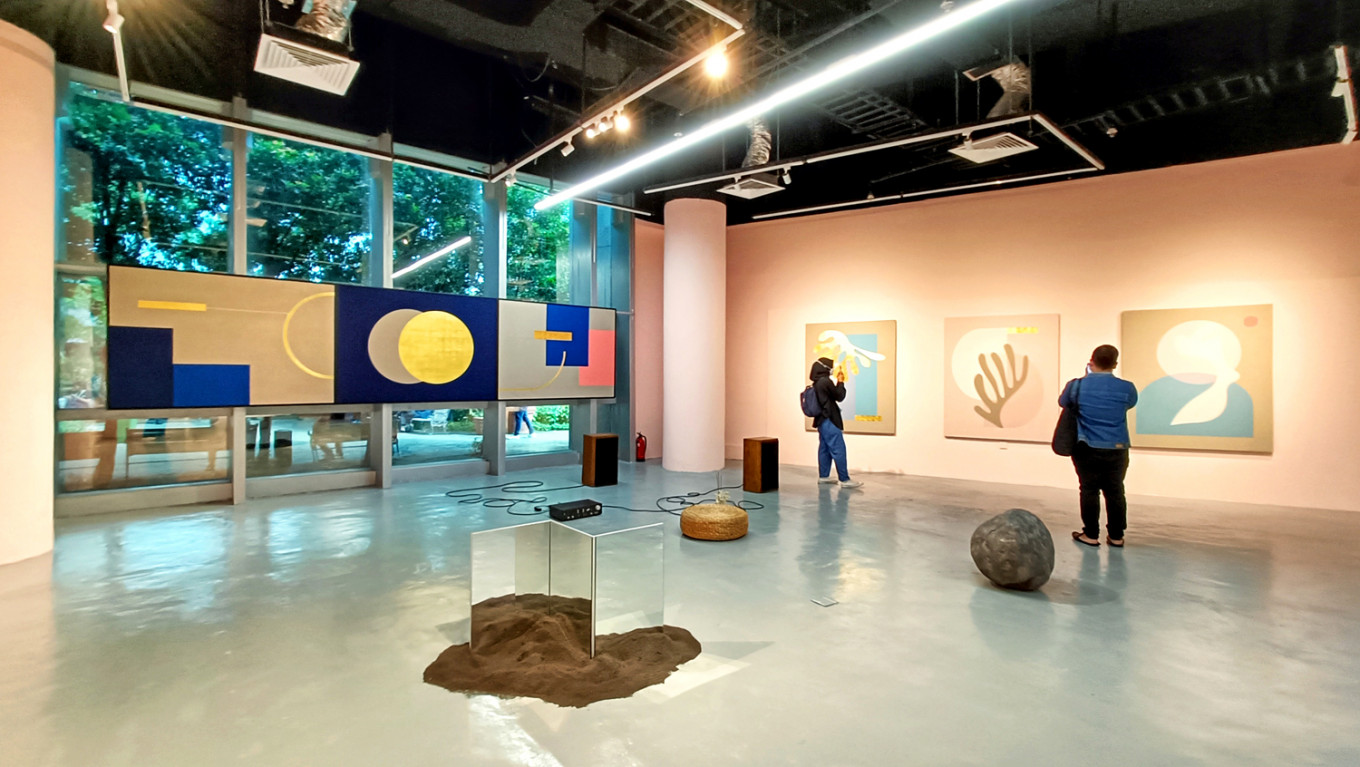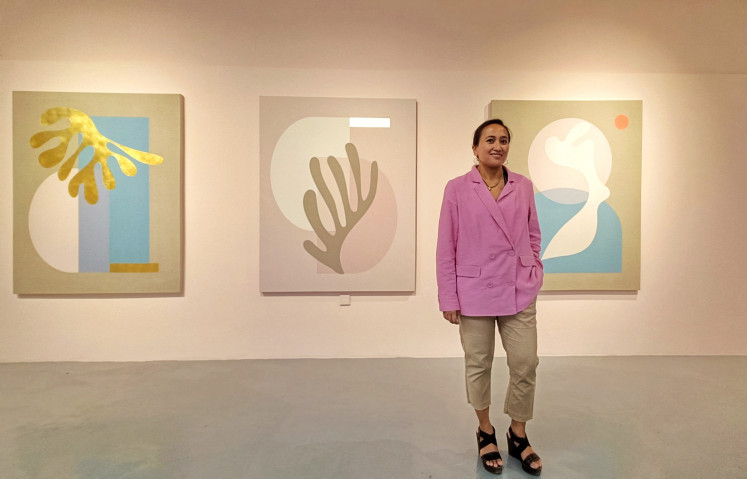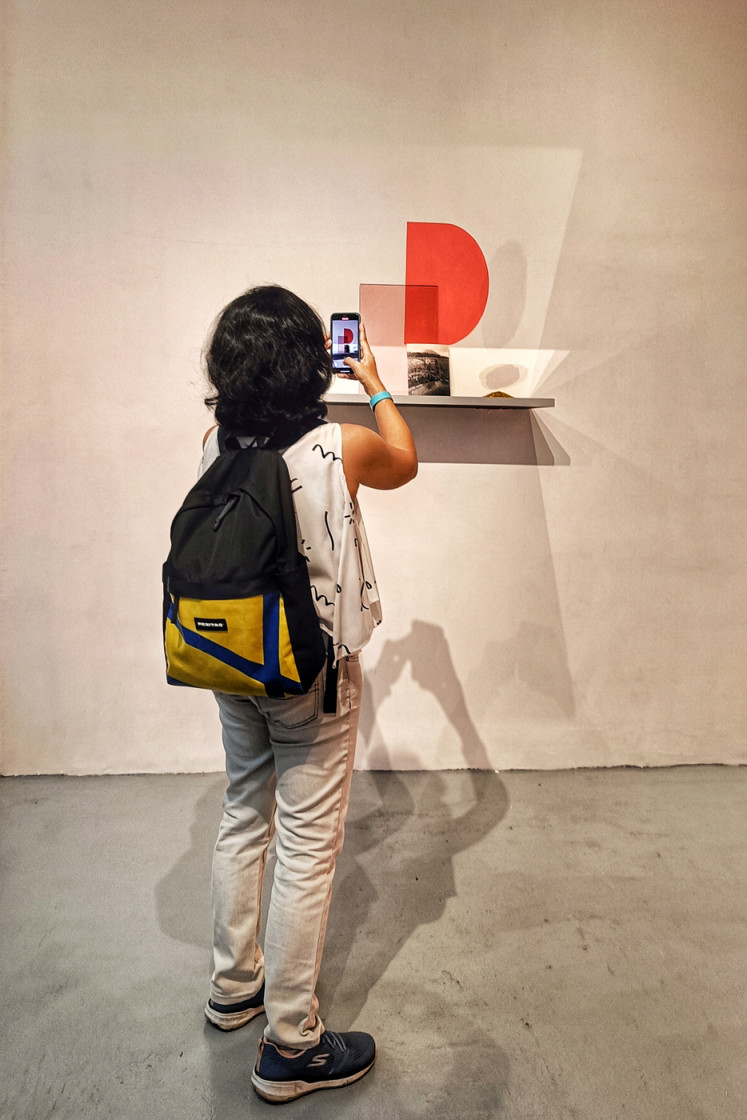Popular Reads
Top Results
Can't find what you're looking for?
View all search resultsPopular Reads
Top Results
Can't find what you're looking for?
View all search resultsSinta Tantra gets up close and personal in Constellations of Beings
Change text size
Gift Premium Articles
to Anyone
The British artist of Balinese descent delves into the familial with her first solo exhibition in Jakarta.
Each family is unique. And the relations between its members ebb and flow according to their life situations. Sinta Tantra, a British artist of Balinese descent, has encapsulated her family’s history in a solo exhibition, titled Constellation of Beings, in Jakarta.
The exhibition, held at the ISA Art Gallery in Wisma 46, Central Jakarta, features two triptychs and nine large abstract paintings, which were all created within this year.
“The paintings are inspired by my family, the story of my father and mother, my grandparents and their fathers and mothers, as well as my own story [and] my personal journey,” Tantra said at the opening of the exhibition on Aug. 5.
The idea for the paintings came when Sinta returned to Bali in 2019 and asked her parents about their childhood stories.
“I was interested in listening to their stories before they were adults, because I think Bali and Indonesia were different back then,” the artist said. “I think that’s an interesting period.”
A 17-minute video of their conversation was also looping on an LED screen in the gallery.
The exhibition, which will last until Sept. 30, was curated by Dutch-Indonesian historian and curator Dr. Sadiah Boonstra.
“For me, admiring Sinta’s works, it’s really a privilege to really work with Sinta on something that’s so dear and something so personal [to her], the stories that her parents shared with Sinta,” Boonstra said.
The exhibition also features a series of installations by the artist, as well as a soft, haunting melody, sounding from a couple of 1970s loudspeakers, by British sound artist Thibaut Vandamme.
A set of incense sticks, stationed at a corner of the gallery, sends off a heady scent of wood and spices into the air.
“I guess I wanted to create an immersive environment [for my painting exhibition] to engage people,” the artist said.
Meet the artist: Sinta Tantra poses in front of a series of paintings dedicated to her maternal family during the opening of the Constellation of Beings exhibition on Aug. 5. (JP/Sylviana Hamdani) (JP/Sylviana Hamdani)Inherited talent
A grand 540-by-130 cm triptych, titled Taksu, meets visitors as they enter the gallery.
“In Balinese, taksu means talents that you’re born with,” the artist said. “For me, it’s just interesting to explore the idea of my creativity and who among my family has a strong [artistic] taksu.”
In the conversation with her parents, Tantra learned that her father’s family, who are native to Karangasem, Bali, had always had a strong artistic streak.
“I discovered that my great grandfather was a highly skilled undagi, which means architect or sculptor in Balinese,” she said.
One of his masterpieces is the Ujung Water Palace in Karangasem, which he and his cousin carved out of stones for the king of Karangasem.
“Back then, they were not paid in money for their work,” Tantra said, in broken Indonesian. “The king instead gifted them with a pomelo tree, which was then planted at the center of the family’s compound.”
Exploring identity
“I’m trying to explore my identity by making art,” Tantra said.
The artist was born in New York in 1979 as her father, who was an executive for Bank Negara Indonesia (BNI), was stationed there. Five years later, Tantra and her family moved to London where she grew up.
Since she was a kid, Tantra has always loved drawing. Aware of her artistic talent, she decided to pursue a BTEC foundation diploma in art and design at Middlesex University in London in 1999.
“At art school, people were expecting me to make batik, or small, intricate artworks,” she said. “I found that quite submissive. I didn’t find that empowering at all. That’s why I went to abstract [art], because it’s quite masculine [and] a way to break stereotypes for me personally.”
In 2000, the artist continued her study and took a bachelor’s degree at the Slade School of Fine Art. Three years later, she also took a postgraduate degree in fine art at the prestigious Royal Academy of Arts in London.
“After that, I thought I’d just be a curator or maybe own a gallery,” she said. “I didn’t see that a woman could be an artist, [moreover] a woman of color, and be successful in somewhere like London.”
Fortunately, a local government official discovered her talent when she was doing a community workshop in North London in 2006. He then commissioned the artist to paint a mural on a bridge in Camden.
“It was my first public art mural,” she said. “For me, it’s exciting to do a big-scale [work]. And I also love serving the public.”
“From there, [my career] sort of developed,” she added.
Today, Tantra runs a studio in Kentish Town, London, in which she plans and designs public artwork and also paints.
“Sometimes, [public artwork and painting conflict with] each other with different ways of thinking,” she said. “But I really enjoy it because it’s using different parts of my brain.”
For her abstract paintings, Tantra uses tempera paint on portrait-oriented linen canvas.
“Tempera is highly pigmented [and has] quite strong colors,” Sinta explained. “But it’s quite difficult to use, because it’s quick-drying, and you have to paint it very quickly.”
The process is also quite labor-intensive. Before painting, Tantra designs and maps out the piece on her computer. She then pours the tempera paint on a stretched canvas, laid horizontally across table trestles, and paints it quickly with a big brush. Afterwards, multiple layers of tempera paint are sanded and recoated to result in a matte, powdery finish.
Tantra also applied 24 karat gold leaf on some of her paintings in the exhibition.
“The combination of the tempera on the linen and the gold leaf creates this structure on the paintings that gives an almost three-dimensional feel to it,” said Dr. Sadiah Boonstra, the curator.
“So if you see the paintings in the pictures, they’re kind of flat, two-dimensional images. But if you see them here in real life, you’ll really see the dialogue between the paint and the linen and the gold leaf.”
Admiring art: A visitor takes a picture of the mirror shelf at the exhibition, which is being held at the ISA Art Gallery in Wisma 46 in Central Jakarta. (JP/Sylviana Hamdani) (JP/Sylviana Hamdani)Strong women
Tantra also explores her maternal family’s history in some of the paintings in the exhibition.
“This wall explores the stories of my mother, grandmother and great grandmother,” she said, while pointing to a wall in the gallery that displays a series of pink-hued paintings.
One of the paintings on the wall, titled Harsiam, is an ode to Sinta’s maternal grandmother.
“[Harsiam] was a strong woman and a single mother,” Sinta said.
The 160-by-130 cm painting, which features a pink circle, white curve and sky-blue semicircle, tells the story of Tantra’s mom, Partini, who dropped a basket of eggs that she was buying for her mom, Harsiam. As the little girl was afraid, she lied about the incident. But late at night, tortured by her own conscience, Partini finally decided to come clean to her mother.
In another painting, titled Mukri (100 by 120 cm), the artist recalls a story of her maternal grandfather.
“He died when my mom was still very young during the revolution,” she said. “She doesn’t even remember his face. But she remembers him always taking her to the river for a bath and combing her wet, long hair with his fingers afterwards.”
When her maternal grandfather went missing during the Indonesian revolutionary war and was presumed dead, they could not find his body at first.
“Then one night, my grandmother was summoned to a river in a dream,” Tantra said. “When she went to the river in the morning, she found his body.”
The incident is depicted in the blue semicircle installation, surrounded by a pile of red-and-white rose petals on the floor at the center of the gallery.
“[The installation] is about paying our respects to older generations, but also about life and death,” Tantra said.
Balinese home
Another interesting installation in the exhibition is a mirror shelf on the wall of the gallery, featuring a red semicircle mural, a 1930s photo of Mount Agung and a pile of golden glitter.
“It reminds me of my Balinese home and of dreaming and migrating,” she said.
“My mother’s great grandparents had moved to Bali from Java,” Tantra said. “My father had moved quite a lot. And I’m also moving quite a bit.”
Does she dream of returning and living in Bali sometime in the future?
“Yes, I think,” Tantra answered. “Or back and forth [between London and Bali]. I hope I’ll be in the position where I can afford to do that.”













